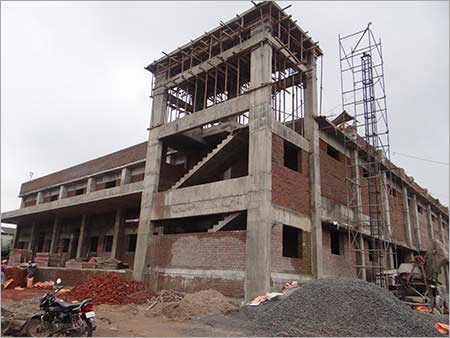Table of Contents
Loads In Buildings:
In the design of any RCC structure, calculation of the upcoming load is the first and foremost step. The design load is considered for its design life. In this post, I will illustrate the basics of the design loads considered while designing of structures & the basic mathematics involved in their calculation.
Types of building loads:
The following given loads are present In a typical residential building as discussed below-
- Dead Load– All the load of the dead or non-moving/stationary/fixed elements of the building fall in this category. Some examples of dead load are the weight of walls, the weight of roof/floor finishes etc. Self-weight of structural members such as beams, columns, Footings & RCC slabs etc are also taken as dead-load. The calculation of live loads has to be done by taking properties of the material & the dimensions of the element considered.
- Live Load– ll the moving loads due to human use or furniture or any other mechanical equipment. For all general categories live loads are defined in Indian Code IS 875 Part-3. Rest if any shall be calculated as per the requirement.
- Dynamic Load – Apart from dead & live loads a building structure is also subjected to the application of dynamic load. Dynamic loads are the loads in which the value & nature of the application of force is not constant throughout & is subjected to changes as per the conditions governing the forces. Forces due to wind, earthquake, traffic or heavy machinery (such as blowers or pumps) fall under this category.
(Also Read: Different Types of Failure of Foundation)
Dead Loads:
- Self-weight– It is the weight of the frame or the individual weight of the structural elements such as Beams, Columns & Slabs. In computer programs such as STAAD Pro inbuilt capability is there which allows the program to calculate the self-weight of the elements automatically in accordance with the shape, size & member dimensions.
Example: Below given are the examples for manual calculation of self-weight of the structural elements.
- Beam: Let it be of any shape Rectangular/square/tee/trapezoid anything, for calculation of weight, use the given formula-
Weight of member = cross-section area of member x length of member x RCC density
For a 0.3 m wide 0.45 m deep beam section of 5 m clear length & material density = 25 kN/m3 (for RCC), the weight will be-
Weight of beam = (0.3 x 0.45) x 5 x 25 = 16.875 kN
The above calculated weight of 16.875 kN is the total weight which can be further converted into Uniformly Distributed Load (UDL) by dividing the total weight by member length.
U.D.L in the beam = 16.875/5 = 3.375 kN/m
- Column: Same as explained above the self-weight of a column can be calculated only the terminology of member length will be changed to member height & the weight of column will be calculated as point load only its conversion in UDL is not required.
- Slab: RCC slabs, the weight of roof slabs is applied as uniform pressure in kN/m2. For analysis purpose, it is we consider a 1 m x 1 m square section & calculate the volume of the RCC & then the same is multiplied with the density for the derivation of pressure in kN/m2.
Weight of slab = (1 x 1 x slab thickness) x RCC density
In the above formula as (1 x 1) doesn’t affect the calculation thus, it can be further simplified as-
Weight of slab = slab thickness x RCC density
For 0.15 m thick slab the calculation will be as follows-
Weight of slab = 0.15 x 25 = 3.75 kN/m2
In the above calculation of RCC slab weight, further additional load due to floor finishes are included generally for stone/cement floorings 0.75 kN/m2 to 1.5 kN/m2 is considered.
Distribution of slab load on supporting beams:
Depending upon the arrangement of beams (square or rectangular) triangular or trapezoidal shape distribution is carried out. For example (refer fig below) in case of a rectangular slab of 6 m x 4 m, the longer side beams spanning between A-B & D-C will carry a load of the corresponding trapezoidal portion. Whereas the shorter span beams spanning between A-D & B-C will support the weight of roof slab coming from the corresponding triangular region.
Load on 6 m span = area of trapezoid x thickness of slab x density
Load on 6 m span = 8 x 0.15 x 25 = 30 kN.
Thus, U.D.L = 30 / member length = 30/6 = 5 kN/m.
Load on 4 m span = area of triangle x thickness of slab x density
Load on 4 m span = 4 x 0.15 x 25 = 15 kN = 15 / member length = 15/4 = 3.75 kN/m

Above discussed was the case of a rectangular slab. In the case of the square slab, the slab plan is divided into 4 number of equal triangles. Then the load for the same is transferred to the corresponding beam members.
- Walls: Generally in building construction brick walls of single brick (0.115 m thick) & double brick (0.230 m thick) is used, a load of brick walls is calculated as follows-
Weight of wall (In kN/m) = Height of wall x thickness of wall x density of brick/stone masonry
For 0.23 m thick wall of 3.2 m clear height, the load will be-
Weight of wall (In kN/m) = 3.2 x 0.230 x 22 = 16.192 kN/m
The load of 16.192 kN/m is applicable in the form of UDL on the beam supporting the brick wall. In the above calculation, brick wall density considered is 22 kN/m3.
Live Loads:
Live loads or imposed loads as per building type & occupancy classification shall be provided as per Indian Code IS 875 Part-2 in table-1.
Dynamic Loads:
Mainly, the following dynamic forces are subjected to RCC buildings-
- Wind Force: Wind load is calculated in line with the provisions of IS : 875 (Part-3).
- Seismic/Earthquake Force: Seismic load is calculated in line with the provisions of IS 1893: 2016.
Methodology for calculation of wind forces & earthquake forces will be discussed in a separate post, keep following.
Hope above given explanation helps in understanding the fundamentals for determination of dead & live loads as per Indian Code.
I hope this article will help you. You may also want to see my other post from my Blog. If I have missed anything here, please let me know about that in the comment below this post.
Share it with your friends.
Happy Learning.
Please help me to share this article with your friends through Facebook, Twitter or WhatsApp. You can also find us on Facebook, Twitter, and Instagram. Also, Subscribe to our mailing list to get new post update from us. And, do me a favour, if you find this post helpful, rate a 5 star below-




